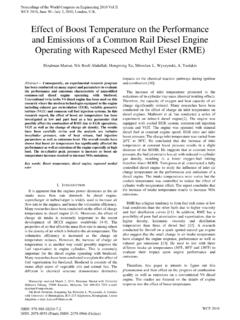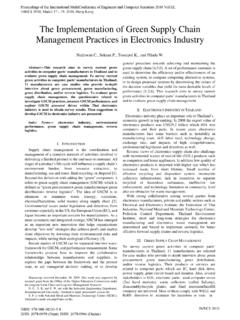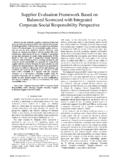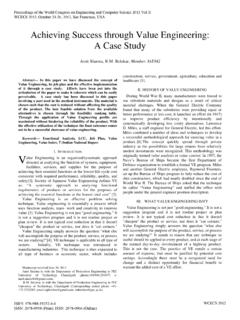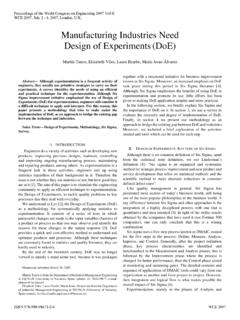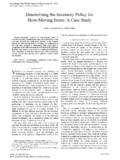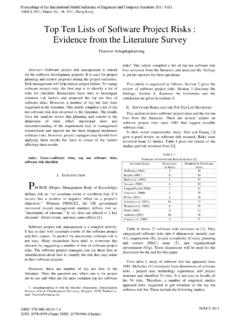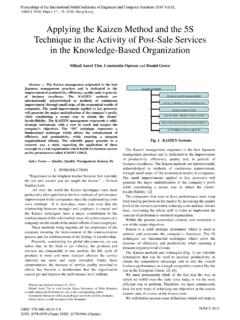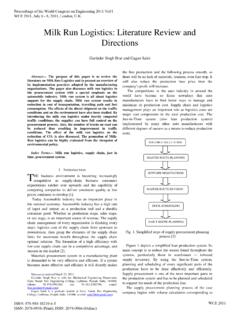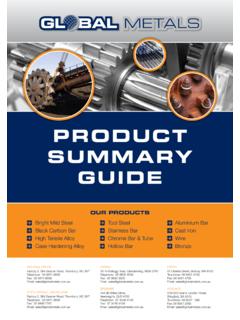Transcription of Corrosion Behaviour of Dissimilar A319 and A356 Cast ...
1 Proceedings of the World Congress on Engineering 2010 Vol II. WCE 2010, June 30 - July 2, 2010, London, Corrosion Behaviour of Dissimilar a319 and A356 Cast Aluminum alloys Joined By Friction Stir Welding (FSW). Ahmed S. Hassan, Tamer S. Mahmoud, Fouad H. Mahmoud and Tarek A. Khalifa precipitates. Coarse precipitates and wide precipitate-free Abstract In the present investigation, the Corrosion zones promoted by the thermal excursion during the welding Behaviour of Dissimilar a319 and A356 cast Al alloys plates are correlated with the intergranular Corrosion . joined by friction stir welding (FSW) was evaluated. The The effect of FSW parameters on Corrosion Behaviour of effects of tool rotational and welding speeds as well as post-weld heat treatment (PWHT) on Corrosion Behaviour friction stir welded joints was reported by many workers were investigated.
2 Plates of a319 and A356 were friction stir [5,9]. The effect of processing parameters such as rotation welded (FSWed) using three different tool rotational speeds speed and traverse speed on Corrosion Behaviour of friction (typically, 1120, 1400 and 1800 rpm) and two welding speeds stir processed high strength precipitation hardenable (typically, 80 and 112 mm/min). The PWHT was carried out AA2219-T87 alloy was investigated by Surekha et al. [9]. using a solution heat treatment temperature of 540 oC for 12. The results indicate that rotation speed has a major in uence hours followed by ageing at 155 C for 6 hours. Corrosion Behaviour of welds was investigated by immersion in sodium in determining the rate of Corrosion , which is attributed to the chloride (NaCl) and hydrogen peroxide (H 2O2) solution for 6 breaking down and dissolution of the intermetallic particles.
3 Hours. The results showed that both as-welded (AW) and Jariyaboon et al. [5] studied the effect of welding parameters PWHTed welds showed better Corrosion resistance than both (rotation speed and travel speed) on the Corrosion Behaviour a319 and A356 base alloys . The Corrosion resistance of the of friction stir welds in the high strength aluminium alloy welded zones was found to be reduced by increasing the tool rotational speed and/or reduction of the welding speed. AA2024 T351. It was found that rotation speed plays a major role in controlling the location of Corrosion attack. Index Terms Friction stir welding, Aluminium cast alloys , Localized intergranular attack was observed in the nugget Corrosion Behaviour . region for low rotation speed welds, whereas for higher rotation speed welds, attack occurred predominantly in the HAZ. I. INTRODUCTION Many investigators studied the Corrosion resistance of Al The Corrosion Behaviour of FSWed aluminium alloys has alloys weld joints made by using FSW and other been described in recent years [1-6].
4 Generally, it has been conventional fusion welding techniques such as Metal Inert found that the weld zones are more susceptible to Corrosion Gas (MIG) and Tungsten Inert Gas (TIG) [10,11]. For than the parent metal. Friction stir (FS) welds of aluminium instance, a comparison of the Corrosion resistance of alloys such as 2219, 2195, 2024, 7075 and 6013 did not AA6060T5 and AA6082T6 joints made by Friction Stir exhibit enhanced Corrosion of the weld zones [1,7,8]. FS Welding (FSW) and Metal Inert Gas (MIG), respectively, is welds of aluminium alloys exhibit intergranular Corrosion reported by Stefano and Chiara [11]. Tests were conducted mainly located along the nugget s heat-affected zone (HAZ) by putting the welded and polished samples in an acid salt and enhanced by the coarsening of the grain boundary solution. Corrosion resistance was detected via morphological analysis of the surface.
5 The attack was Manuscript received February 20, 2010 localized (pitting), an index referred to the pit density was Ahmed S. Hassan is an M. Sc. Student at Mechanical Engineering used for the comparison. The results indicated that joints Department, Benha University, Shoubra faculty of Engineering, Cairo, Egypt. (Phone: 002-010-8266688; fax: 002-02-22023336; e-mail: welded using FSW are more resistant to Corrosion than those welded using MIG. An experimental investigation has been Tamer S. Mahmoud is an Associate Professor at Mechanical Engineering carried out, by Squillace et al. [10], on microstructure and Department, Shoubra Faculty of Engineering, Benha University, Cairo, Egypt. Currently at King Khaled University (KKU), Faculty of Engineering, Abha, Corrosion resistance of weld butt joints of AA 2024-T3. Kingdom of Saudi Arabia, (Phone: 00966-054-8688576; fax: welded using FSW and TIG techniques.))
6 Polarization curve 00966-62418184;e-mail:Tsmer@ or Fouad H. Mahmoud is an Associate Professor at Mechanical Engineering tests and electrochemical impedance spectroscopy showed a Department, Shoubra Faculty of Engineering, Benha University, Cairo, Egypt. nobler Behaviour of weld bead with respect to parent alloy. In (Phone:002-010-0036141; fax: 002-02-22023336; e-mail: FSW joints, however, the differences between the nugget, Tarek A. Khalifa is a Professor at Mechanical Engineering Department, thermo-mechanically affected zones (TMAZ) and heat Shoubra Faculty of Engineering, Benha University, Cairo, Egypt. (Phone: affected zones (HAZ) were not so evident as in TIG joints;. 002-010-1343329; fax:002-02-22023336; e-mail: tkhalifa50@ ). what is more, inside FSW weld bead, the retreating zone showed a Behaviour nobler than the advancing one. ISBN: 978-988-18210-7-2 WCE 2010.)
7 ISSN: 2078-0958 (Print); ISSN: 2078-0966 (Online). Proceedings of the World Congress on Engineering 2010 Vol II. WCE 2010, June 30 - July 2, 2010, London, It has been found that most of the work carried out in the energy dispersive X-ray spectroscopy (EDX) analysis system. field of Corrosion resistance of FSW is focusing on wrought Additionally, second phases in the stir zone were identified Al alloys [1-11], especially, high strength alloys such as by the X-ray diffraction (XRD) method. The sizes of the 7 XXX and 2 XXX series. Corrosion resistance of cast primary Si particulates were measured using standard aluminium alloys such as a319 and A356 FSW joints has not quantitative methods via a metallurgical image analyzer. been reported. However, the mechanical and microstructural Vickers hardness at the centre of the processed zone was characteristics of FSWed joints of such alloys have been measured for both AW and PWHTed samples on the examined extensively by many workers [12-15].
8 The aim of cross-section perpendicular to the welding direction using a the present work is to study the Corrosion Behaviour of load of 1 kg. The hardness measurements were conducted on Dissimilar a319 and A356 cast aluminium alloys plates specimens prepared for metallographic examination. joined by FSW. The effect of tool rotational and welding speeds as well as PWHT on Corrosion resistance of the welded joints is studied. II. EXPERIMENTAL PROCEDURE. In the current investigation, Dissimilar joints of cast aluminium alloys A356 and a319 were produced using FSW. Plates of such alloys were received in the form of ingots and machined into thick plates having the dimensions of [50. mm (width) 250 mm (length) 10 mm (thickness)]. The chemical composition of the A356 aluminium alloy (by weight percent) was Si, Fe, Cu, Mg, Zn, Ti and balance Al. While the chemical composition of the a319 aluminium alloy (by weight percent) was Si, Fe, 3% Cu, Mg, Zn, Mn and balance Al.
9 The FSW operation carried out in the present work is shown in which indicates the tool rotational and welding directions. It is clear that the tool was rotating at a counter clockwise direction. On the basis of preliminary FSW operation (a) and tool dimensions (b). studies the A356 al alloy was placed at the retreating side and the a319 al alloy on the advancing side of the rotating Immersion Corrosion tests were performed on etched tool. A steel tool made from H13 steel was used as a welding AW and heat treated samples according to ASTM standard tool. The chemical composition of the tool material was G110 [16]. This standard practice evaluates the C, Mn, Cr, V, Mo, Si intergranular Corrosion resistance of heat treatable and balance Fe. The tool has a simple cylindrical shape aluminium alloys by immersion in sodium chloride (NaCl). shown in Fig 1b. The rotating pin travels along the butt line + hydrogen peroxide solution (H2O2).
10 The samples were between the two parent alloys . The welding processes were immersed in a solution of 57 g/l ( M) NaCl and 10 ml/l conducted using a vertical CNC milling machine at three H2O2 ( M) for 6 h. Prior to immersion in the test different tool rotation speeds, typically; 1120, 1400 and 1800 solution, the samples were cleaned with acetone to remove rpm and two different welding speeds of 80 and 112 organic materials such as oils and other residuals. mm/min. In all experiments, the tool angle was fixed at 2 Specimens were then immersed for 1 min in etching and the friction pressure was held constant by keeping the cleaner ( 945 ml of reagent water + 50 ml of nitric acid tool s shoulder penetration depth inside the work piece (70%) + 5 ml of hydrofluoric acid (48%) ) followed by constant at 2 mm. washing in reagent water. After that, the specimens were Post weld heat treatment (PWHT) of welds was carried out immersed in concentrated nitric acid (70%) for 1 min using a solution heat treatment temperature of 540 oC for 12 followed by washing in reagent water and dry air.
